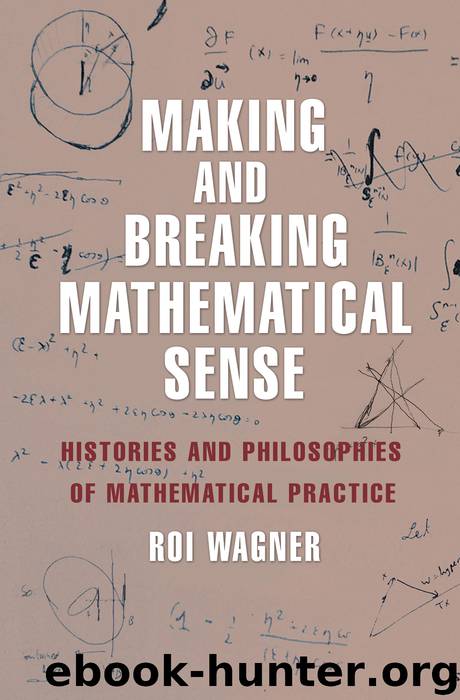Making and Breaking Mathematical Sense by Wagner Roi;

Author:Wagner, Roi; [Wagner, Roi;]
Language: eng
Format: epub
ISBN: 9780691171715
Publisher: Princeton University Press
Published: 2016-01-15T07:00:00+00:00
Mathematical Language and Its Reality
It would be extremely uncharitable to assume that any of the cited researchers genuinely believes that the stable marriage model is a perfectly adequate description of social reality. Indeed, the gap between the model and the supposed reality is not ignored in the literature. One can read that “We will sometimes speak about courtship, but never of dependent children or mid-life crises” (Roth and Sotomayor 1990, 1), and that “This makes the (somewhat unrealistic) assumption that it is always better to be married (to an acquaintance) than to stay single” (Bollobás 1998, 85). Some texts consider the entire marriage terminology as “frivolous” but continue to use it anyway (Wilson 1996, 113).
Nevertheless, the literature does contain statements that indicate that the analysis and its results are taken as representative of reality, such as “Societal habits thus favor men” (West 1996, 177), and “We shall give a result which perhaps demonstrates an effect of complete inequality of the sexes” (Asratian et al. 1998, 70). When one reads that “The algorithm is the codification of old fashioned etiquette” (Bollobás 1998, 86), one reads a rather doubtful and revisionist social history.
The realistic interpretation of the mathematical problem is reinforced when shifting from the marriage context to the job-assignment formulation of the same problem. The latter is considered as “more serious,” even though this version too abstracts and ideologizes many factors that drive mathematical analysis away from any social reality that it purports to seriously emulate.
The most widely discussed applications of stable matching schemes are the matching of residents to hospitals and of students to schools. If we consider information gaps (people don’t always know each other’s preferences, and so can’t tell if there’s an opportunity to “elope”), change of mind and hesitation (preferences are contingent, change over time, and may depend on what is learned over time of others’ preferences), contractual obligations, and practical impediments (which may prevent “rogue couples” from “eloping” even if such couples do exist), stability may become less relevant.
The applicability of stability to actual, real life contexts has only been considered seriously since the mid-1980s. Roth and Sotomayor (1990) survey some aspects of stability in applications. To be fair, their analysis is lucid enough to raise many pertinent objections, including some of those mentioned earlier. They even write (1990, 156): “at least one of the authors would feel very differently about the theory presented here if the weight of the empirical evidence were different.” But as is often the case in mathematical game theory and economy (recall our Black-Scholes vignette), the interpretation of empirical evidence allows ideological commitments to gain the upper hand. It was in fact the very evidence raised by Roth and Sotomayor that evinced my suspicion that the success or failure of a matching scheme in contemporary applications may not depend heavily on stability, but rather on other factors.
In fact, the Gale-Shapley algorithm was introduced in 1962. It had, however, already been in use for eleven years by that time. Since 1951, residents
Download
This site does not store any files on its server. We only index and link to content provided by other sites. Please contact the content providers to delete copyright contents if any and email us, we'll remove relevant links or contents immediately.
| Anthropology | Archaeology |
| Philosophy | Politics & Government |
| Social Sciences | Sociology |
| Women's Studies |
The remains of the day by Kazuo Ishiguro(8383)
Tools of Titans by Timothy Ferriss(7808)
Giovanni's Room by James Baldwin(6807)
The Black Swan by Nassim Nicholas Taleb(6761)
Inner Engineering: A Yogi's Guide to Joy by Sadhguru(6439)
The Way of Zen by Alan W. Watts(6288)
Asking the Right Questions: A Guide to Critical Thinking by M. Neil Browne & Stuart M. Keeley(5355)
The Power of Now: A Guide to Spiritual Enlightenment by Eckhart Tolle(5330)
The Six Wives Of Henry VIII (WOMEN IN HISTORY) by Fraser Antonia(5235)
Astrophysics for People in a Hurry by Neil DeGrasse Tyson(5000)
12 Rules for Life by Jordan B. Peterson(4160)
Housekeeping by Marilynne Robinson(4059)
The Ethical Slut by Janet W. Hardy(4036)
Skin in the Game by Nassim Nicholas Taleb(3965)
Double Down (Diary of a Wimpy Kid Book 11) by Jeff Kinney(3922)
Ikigai by Héctor García & Francesc Miralles(3889)
The Art of Happiness by The Dalai Lama(3844)
Skin in the Game: Hidden Asymmetries in Daily Life by Nassim Nicholas Taleb(3720)
Walking by Henry David Thoreau(3681)
